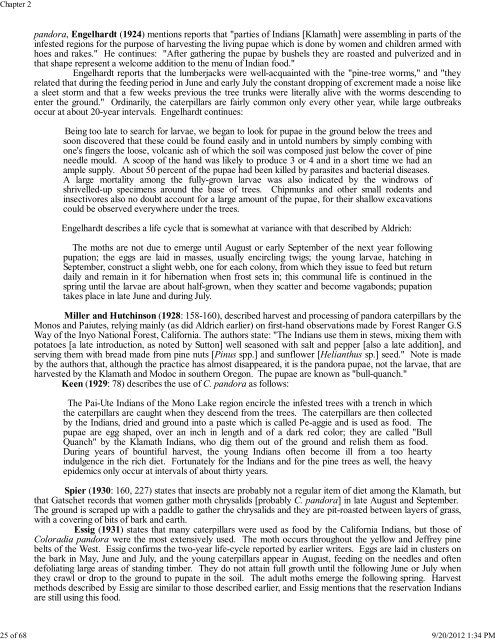Chapter 2. Insect Foods of North American Indigenous Populations ...
Chapter 2. Insect Foods of North American Indigenous Populations ...
Chapter 2. Insect Foods of North American Indigenous Populations ...
You also want an ePaper? Increase the reach of your titles
YUMPU automatically turns print PDFs into web optimized ePapers that Google loves.
<strong>Chapter</strong> 225 <strong>of</strong> 68 9/20/2012 1:34 PMpandora, Engelhardt (1924) mentions reports that "parties <strong>of</strong> Indians [Klamath] were assembling in parts <strong>of</strong> theinfested regions for the purpose <strong>of</strong> harvesting the living pupae which is done by women and children armed withhoes and rakes." He continues: "After gathering the pupae by bushels they are roasted and pulverized and inthat shape represent a welcome addition to the menu <strong>of</strong> Indian food."Engelhardt reports that the lumberjacks were well-acquainted with the "pine-tree worms," and "theyrelated that during the feeding period in June and early July the constant dropping <strong>of</strong> excrement made a noise likea sleet storm and that a few weeks previous the tree trunks were literally alive with the worms descending toenter the ground." Ordinarily, the caterpillars are fairly common only every other year, while large outbreaksoccur at about 20-year intervals. Engelhardt continues:Being too late to search for larvae, we began to look for pupae in the ground below the trees andsoon discovered that these could be found easily and in untold numbers by simply combing withone's fingers the loose, volcanic ash <strong>of</strong> which the soil was composed just below the cover <strong>of</strong> pineneedle mould. A scoop <strong>of</strong> the hand was likely to produce 3 or 4 and in a short time we had anample supply. About 50 percent <strong>of</strong> the pupae had been killed by parasites and bacterial diseases.A large mortality among the fully-grown larvae was also indicated by the windrows <strong>of</strong>shrivelled-up specimens around the base <strong>of</strong> trees. Chipmunks and other small rodents andinsectivores also no doubt account for a large amount <strong>of</strong> the pupae, for their shallow excavationscould be observed everywhere under the trees.Engelhardt describes a life cycle that is somewhat at variance with that described by Aldrich:The moths are not due to emerge until August or early September <strong>of</strong> the next year followingpupation; the eggs are laid in masses, usually encircling twigs; the young larvae, hatching inSeptember, construct a slight webb, one for each colony, from which they issue to feed but returndaily and remain in it for hibernation when frost sets in; this communal life is continued in thespring until the larvae are about half-grown, when they scatter and become vagabonds; pupationtakes place in late June and during July.Miller and Hutchinson (1928: 158-160), described harvest and processing <strong>of</strong> pandora caterpillars by theMonos and Paiutes, relying mainly (as did Aldrich earlier) on first-hand observations made by Forest Ranger G.SWay <strong>of</strong> the Inyo National Forest, California. The authors state: "The Indians use them in stews, mixing them withpotatoes [a late introduction, as noted by Sutton] well seasoned with salt and pepper [also a late addition], andserving them with bread made from pine nuts [Pinus spp.] and sunflower [Helianthus sp.] seed." Note is madeby the authors that, although the practice has almost disappeared, it is the pandora pupae, not the larvae, that areharvested by the Klamath and Modoc in southern Oregon. The pupae are known as "bull-quanch."Keen (1929: 78) describes the use <strong>of</strong> C. pandora as follows:The Pai-Ute Indians <strong>of</strong> the Mono Lake region encircle the infested trees with a trench in whichthe caterpillars are caught when they descend from the trees. The caterpillars are then collectedby the Indians, dried and ground into a paste which is called Pe-aggie and is used as food. Thepupae are egg shaped, over an inch in length and <strong>of</strong> a dark red color; they are called "BullQuanch" by the Klamath Indians, who dig them out <strong>of</strong> the ground and relish them as food.During years <strong>of</strong> bountiful harvest, the young Indians <strong>of</strong>ten become ill from a too heartyindulgence in the rich diet. Fortunately for the Indians and for the pine trees as well, the heavyepidemics only occur at intervals <strong>of</strong> about thirty years.Spier (1930: 160, 227) states that insects are probably not a regular item <strong>of</strong> diet among the Klamath, butthat Gatschet records that women gather moth chrysalids [probably C. pandora] in late August and September.The ground is scraped up with a paddle to gather the chrysalids and they are pit-roasted between layers <strong>of</strong> grass,with a covering <strong>of</strong> bits <strong>of</strong> bark and earth.Essig (1931) states that many caterpillars were used as food by the California Indians, but those <strong>of</strong>Coloradia pandora were the most extensively used. The moth occurs throughout the yellow and Jeffrey pinebelts <strong>of</strong> the West. Essig confirms the two-year life-cycle reported by earlier writers. Eggs are laid in clusters onthe bark in May, June and July, and the young caterpillars appear in August, feeding on the needles and <strong>of</strong>tendefoliating large areas <strong>of</strong> standing timber. They do not attain full growth until the following June or July whenthey crawl or drop to the ground to pupate in the soil. The adult moths emerge the following spring. Harvestmethods described by Essig are similar to those described earlier, and Essig mentions that the reservation Indiansare still using this food.
















